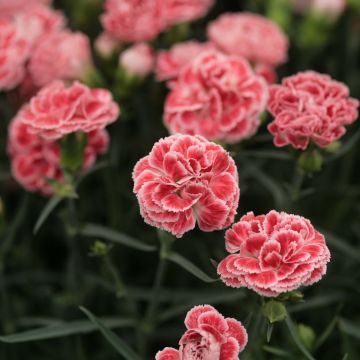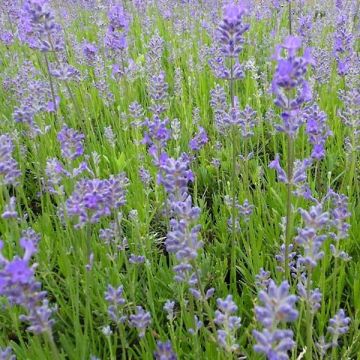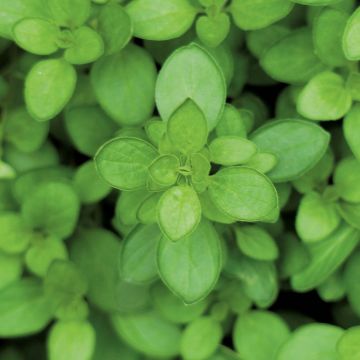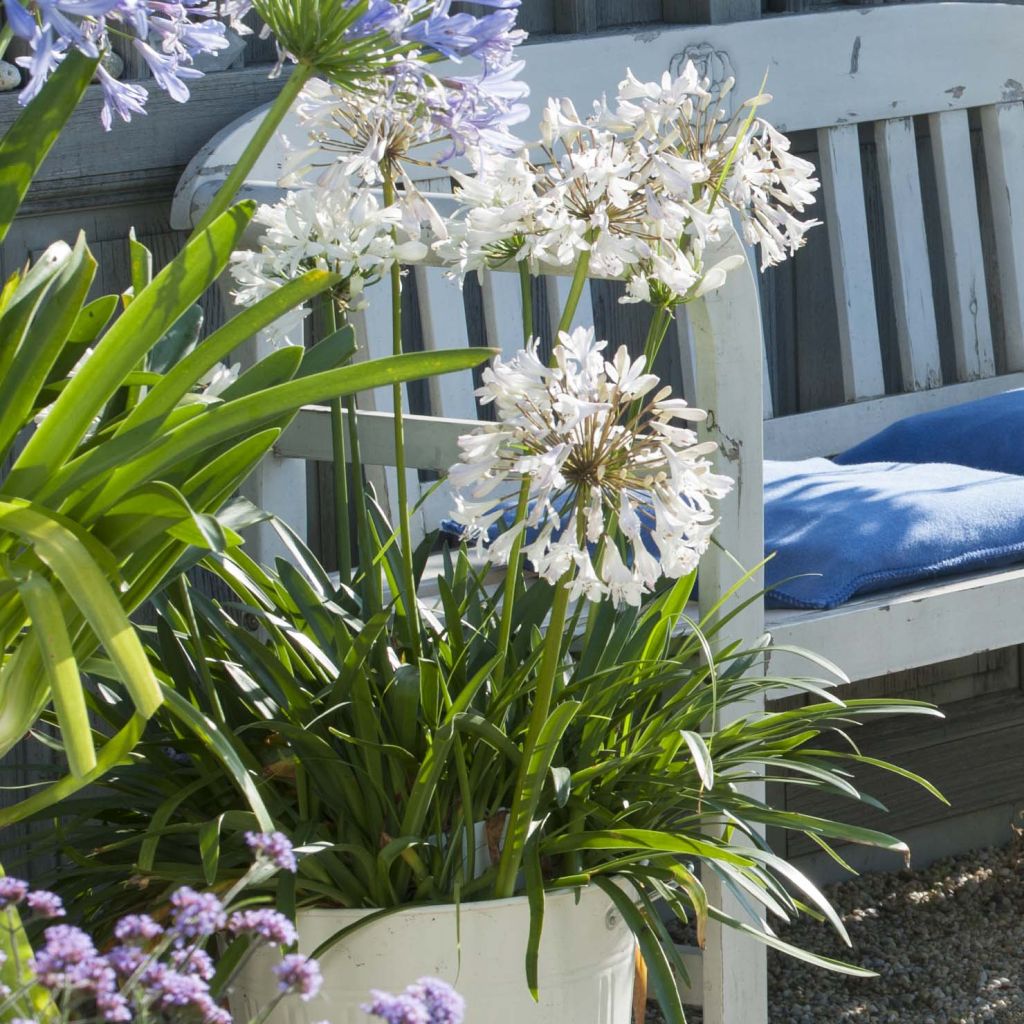

Agapanthus africanus Polar Ice


Agapanthus africanus Polar Ice


Agapanthus africanus Polar Ice
Agapanthus africanus Polar Ice
Agapanthus x africanus Polar Ice
African Lily, Lily of the Nile
This item cannot be shipped to the selected country
Delivery charge from €5.90
Delivery charge from €5.90
Delivery charge from €5.90
More information
Delivery charge from €5.90
Delivery charge from €5.90
Delivery charge from €5.90
More information
Schedule delivery date,
and select date in basket
This plant carries a 12 months recovery warranty
More information
We guarantee the quality of our plants for a full growing cycle, and will replace at our expense any plant that fails to recover under normal climatic and planting conditions.
From €5.90 for pickup delivery and €6.90 for home delivery
Express home delivery from €8.90.
From €5.90 for pickup delivery and €6.90 for home delivery
Express home delivery from €8.90.
From €5.90 for pickup delivery and €6.90 for home delivery
Express home delivery from €8.90.
Does this plant fit my garden?
Set up your Plantfit profile →
Description
The Agapanthus africanus Polar Ice is a highly floriferous variety of agapanthus, boasting large umbels of pure white flowers with an iridescent texture that appears like frost in full sun. This medium-sized plant is adorned with ribbon-like foliage that remains attractive even when not in bloom. It is hardy down to approximately -8°C in well-draining soil.
Both originating from South Africa, Agapanthus umbellatus (or africanus) and Agapanthus praecox are two different species, although they can hybridise naturally in the wild or in gardens. Agapanthus umbellatus is a robust, evergreen plant that grows in South Africa, specifically from the Cape Peninsula to Swellendam, at low altitudes, in mountainous areas, between rocky outcrops, and on sandy soils with an acidic tendency. The Polar Ice cultivar, similar to the Agapanthus umbellatus, grows and multiplies rapidly from a stump with fleshy rhizomes. It forms a dense clump of linear, shiny green foliage that can expand over time and reach a diameter of at least 60 cm (23.6 in). The flowering season for both species is in summer from June-July to August-September. Numerous sturdy stems, on average 80 cm (31.5 in) tall, emerge from the foliage clump. They bear large hemispherical umbels, 15 cm (5.9 in) in diameter, composed of about thirty small campanulate flowers of extraordinary white, almost sparkling, enhanced by delicate brown stamens.
The Polar Ice agapanthus is a stunning addition to any garden, with its large inflorescences that exceed the size of a well-filled clump. The white and luminous flowers, paired with their abundance, will add an elegant and exotic touch to your flower beds. Unfortunately, this plant is only semi-hardy and will not survive temperatures below -6/-8°C, which is why it should be placed in a protected, south-facing location with thick mulch at its base. This versatile plant can be used in a wide range of settings, including beds, borders, large rockeries, pots, and containers. It is especially suited to mild coastal climates and looks beautiful when combined with other mauve or blue varieties in minimalist settings. It adds a touch of exoticism to any bed, especially when paired with Kniphofias, Hemerocallis, Phlomis fruticosa, and Cannas. In mild climates, it can flower multiple times.
Agapanthus africanus Polar Ice in pictures
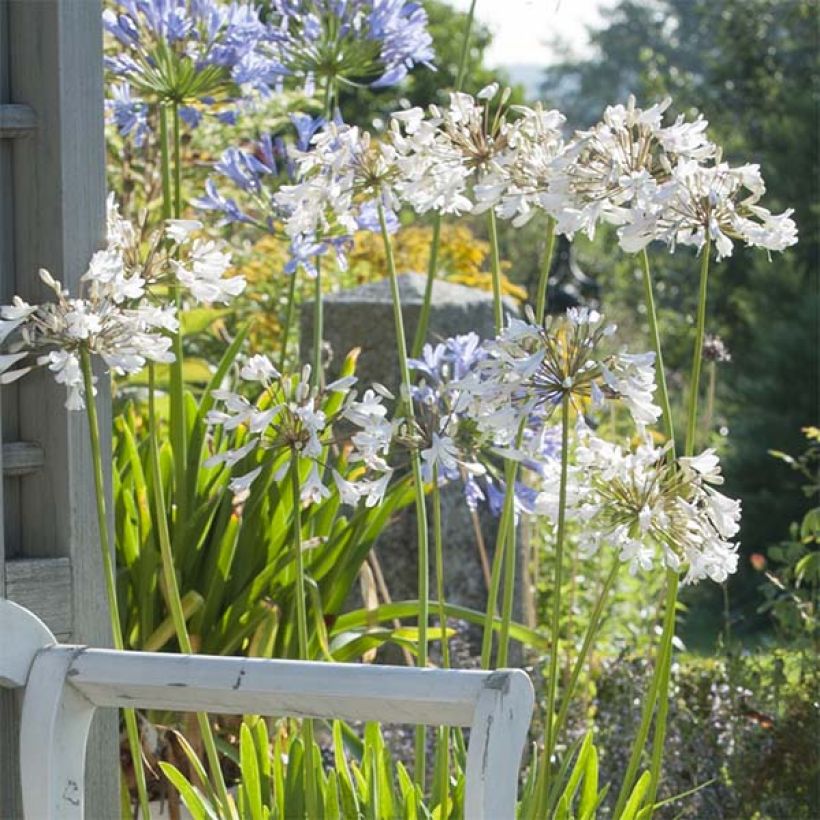





Flowering
Foliage
Plant habit
Botanical data
Agapanthus
x africanus
Polar Ice
Alliaceae - Liliaceae
African Lily, Lily of the Nile
South Africa
Other Agapanthus - Lily of the Nile
Planting and care
To protect your Agapanthus Polar Ice plants from the cold, covering their stumps with at least 10 cm (3.9 in) of good soil is best. Make sure to plant them in spring and mulch them in winter. If you're growing them in a pot, use 5 young plants for a 24 cm (9.4 in) pot, and remember to shelter your pots in winter. These plants thrive in rich and moist yet well-drained soil enriched with sand. Water them twice a week during the growth period, but avoid watering them later on. They don't like excess moisture in winter. Agapanthus 'Polar Ice' plants do well in rockeries and containers, especially when grown in a slightly acidic, sandy mixture. To encourage abundant flowering, regularly feed the plant with a slow-release fertiliser. They prefer shallow but wide containers.
Planting period
Intended location
Care
Mediterranean perennials
Haven't found what you were looking for?
Hardiness is the lowest winter temperature a plant can endure without suffering serious damage or even dying. However, hardiness is affected by location (a sheltered area, such as a patio), protection (winter cover) and soil type (hardiness is improved by well-drained soil).

Photo Sharing Terms & Conditions
In order to encourage gardeners to interact and share their experiences, Promesse de fleurs offers various media enabling content to be uploaded onto its Site - in particular via the ‘Photo sharing’ module.
The User agrees to refrain from:
- Posting any content that is illegal, prejudicial, insulting, racist, inciteful to hatred, revisionist, contrary to public decency, that infringes on privacy or on the privacy rights of third parties, in particular the publicity rights of persons and goods, intellectual property rights, or the right to privacy.
- Submitting content on behalf of a third party;
- Impersonate the identity of a third party and/or publish any personal information about a third party;
In general, the User undertakes to refrain from any unethical behaviour.
All Content (in particular text, comments, files, images, photos, videos, creative works, etc.), which may be subject to property or intellectual property rights, image or other private rights, shall remain the property of the User, subject to the limited rights granted by the terms of the licence granted by Promesse de fleurs as stated below. Users are at liberty to publish or not to publish such Content on the Site, notably via the ‘Photo Sharing’ facility, and accept that this Content shall be made public and freely accessible, notably on the Internet.
Users further acknowledge, undertake to have ,and guarantee that they hold all necessary rights and permissions to publish such material on the Site, in particular with regard to the legislation in force pertaining to any privacy, property, intellectual property, image, or contractual rights, or rights of any other nature. By publishing such Content on the Site, Users acknowledge accepting full liability as publishers of the Content within the meaning of the law, and grant Promesse de fleurs, free of charge, an inclusive, worldwide licence for the said Content for the entire duration of its publication, including all reproduction, representation, up/downloading, displaying, performing, transmission, and storage rights.
Users also grant permission for their name to be linked to the Content and accept that this link may not always be made available.
By engaging in posting material, Users consent to their Content becoming automatically accessible on the Internet, in particular on other sites and/or blogs and/or web pages of the Promesse de fleurs site, including in particular social pages and the Promesse de fleurs catalogue.
Users may secure the removal of entrusted content free of charge by issuing a simple request via our contact form.














































